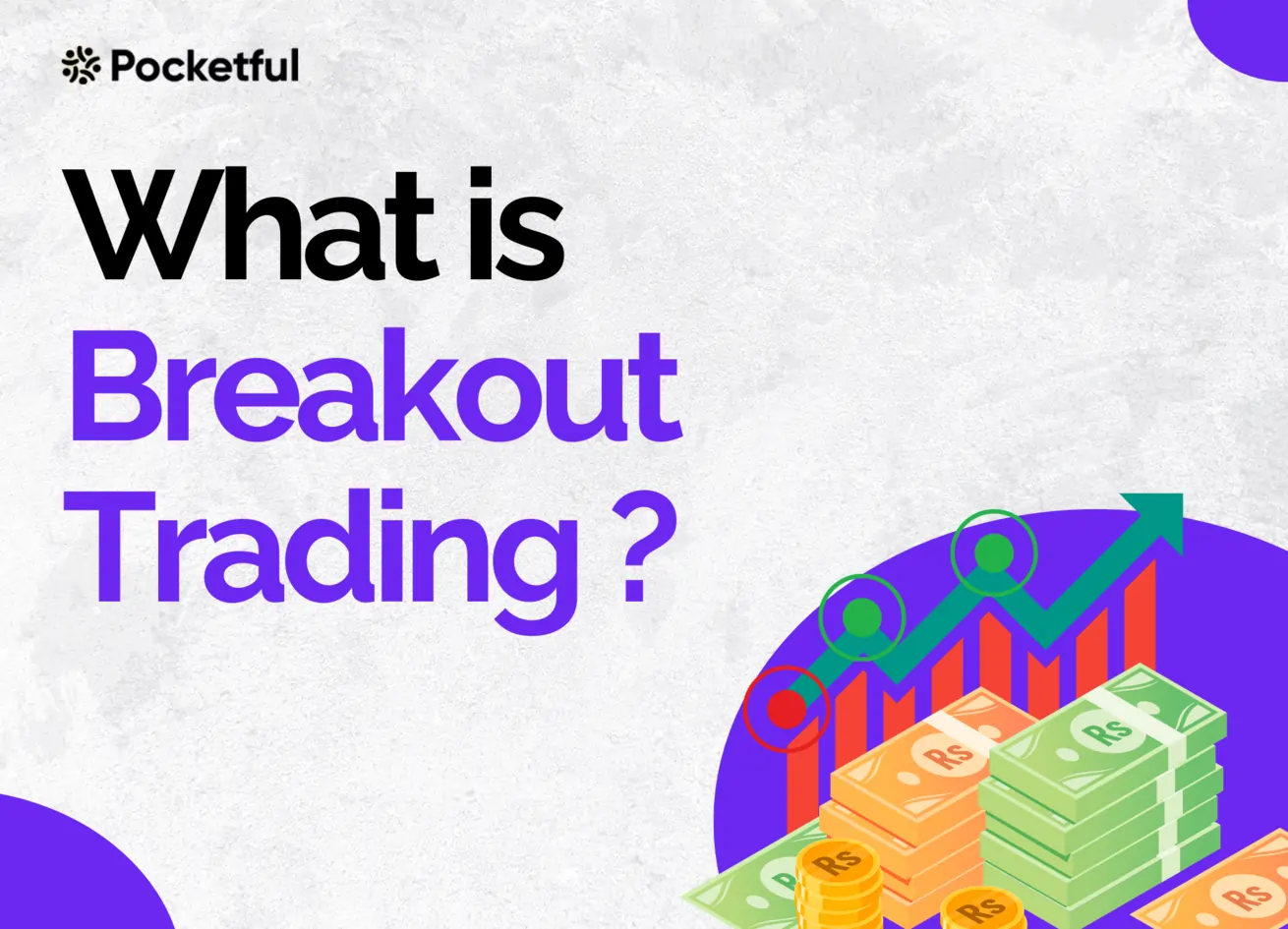| Type | Description | Contributor | Date |
|---|---|---|---|
| Post created | Pocketful Team | Jun-20-24 | |
| Add new links | Nisha | Mar-18-25 |
Breakout Trading: Definition, Pros, And Cons

Did you know there is a way for traders to make money when security breaks through support or resistance levels? In this blog, we will cover Breakout Trading in depth, including its method, pros, and cons.
What is Breakout Trading?
Traders who do breakout trading look for price levels that security has not been able to break through before and take advantage of the significant price changes that happen when the price does. In simple terms, Breakout trading is spotting the trend when a stock price breaks through the key level, like a resistance or support point. These levels are like roadblocks that the price struggles to pass, but when it finally passes through, it often triggers significant price movements, giving traders a chance to cash in. Price history, technical signs, and chart trends are often used to find such breakout points.
Strategy of Breakout Trading

Spotting Support and Resistance: On the chart, you need to find crucial support and resistance levels. The support level acts as the floor and the resistance acts as the ceiling. Look for the places where the price of the security has bounced back multiple times.
Keeping an eye out for breakouts: Always monitor the price of the securities for possible breakouts. Look for price changes that go beyond the established levels of support or resistance, along with a rise in trading volume and momentum.
Stop-Loss: Always place stop-loss orders to manage risks. This will help to limit potential big losses. Make a proper execution plan considering the risk-reward ratio and stick to it.
Profit Targets: The profit target needs to be set based on parameters such as distance between the support and resistance levels, volumes & momentum, market sentiments, etc.
Pros of Breakout Trading
- Clear Exit & Entry Points: Breakout trading provides clear exit and entry points, which makes it easier for traders to execute trades.
- Potential for significant gains: Traders can make substantial money when they correctly spot a breakout. The breakouts can lead to significant price movements, offering the potential for large profits.
- Suitable for different time frames: The breakout strategy can be adapted to different time frames, whether you are an intraday or swing trader. The swing traders use daily or weekly charts, while intraday traders focus on minute or hourly charts.
- Simple to understand & implement: The Breakout strategy can be used by traders of all experience levels as it relies on basic chart analysis and can be enhanced with other technical indicators, that are simple to understand and implement.
- Universal Application: Traders can make use of the Breakout strategy across all asset classes, such as equities, currencies, commodities, etc., as it relies solely on price action.
Cons of Breakout Trading
- False Breakout Signals: Dealing with false breakouts is one of the biggest challenges in breakout trading. A fake breakout happens when the price moves beyond a key level but quickly reverses, which results in a loss. If a false breakout is not managed properly, it can be frustrating and costly.
- Large Losses: If there are chances of a huge profit, then there are also chances of large losses if the breakout fails. It is suggested that stop-loss orders be set to avoid significant drawdowns.
- Constant Attention: Breakout trading often needs constant market tracking, due to the fast price changes, which can be cumbersome and time-consuming for many traders.
Tips for Breakout Trading

- Using Multiple Indicators: By using multiple other technical indicators for confirmation, you can enhance your breakout strategy. Other indicators such as Bollinger bands, moving averages, MACD, relative strength index (RSI), etc. can help validate the strength of a breakout.
- Risk Management: Develop a proper entry and exit plan before initiating a trade and rigidly follow the plan. Further, it is suggested to use stop-loss to protect your capital.
- Keep yourself updated: Stay up to date with the market news and events that can impact the price movements of the overall market or securities you want to trade.
- Trading Journal: Record your trades, including entry and exit points, stop-loss levels, profit targets, and the rationale behind each trade, and review your journal regularly. It will help you learn from your successes and mistakes.
Read Also: Descending Triangle Pattern in Stock Trading
Conclusion
In summation, the Breakout trading is a powerful strategy that, when used properly, may provide substantial profits. With its clear entry and exit points, it has the potential to generate significant gains. Traders may increase their chances of success by learning what breakout trading is, putting a well-defined strategy into practice, and being aware of its benefits and drawbacks.
Breakout trading takes patience, discipline, and ongoing learning, just like any other trading approach. As everything in this world has two sides, breakout trading also carries certain limitations. You must be careful about the risks that come with it.
Despite the risks, breakout trading can help you achieve your objectives and capitalize on market opportunities when combined with other technical analysis tools and risk management techniques. Whether you are new to trading or looking to diversify your strategies, breakout trading is worth considering to capture market moves.
Frequently Asked Questions (FAQs)
What is breakout trading?
In breakout trading, traders wait for a security’s price to break through important support or resistance levels, indicating a potential move in one direction.
What do you mean by a breakout in simple terms?
In a breakout, a stock’s price surpasses a support or resistance level, accompanied by increased trading volume, which signals a potentially significant move in that direction.
What are the benefits of breakout trading?
There are many benefits of breakout trading, such as the chance to make substantial profits, clear entry and exit spots, and the ability to profit from strong market trends.
What risks are there in breakout trading?
One of the risks in breakout trading is false signals, which happen when the price returns to the initial price after breaking a key level.
Is breakout trading good for beginners?
Although newbies can use breakout trading, they must learn to find key levels, trading nuances, and proper risk management. Further, it is suggested that virtual trading be started first and gradually start with real money.
Disclaimer
The securities, funds, and strategies discussed in this blog are provided for informational purposes only. They do not represent endorsements or recommendations. Investors should conduct their own research and seek professional advice before making any investment decisions.